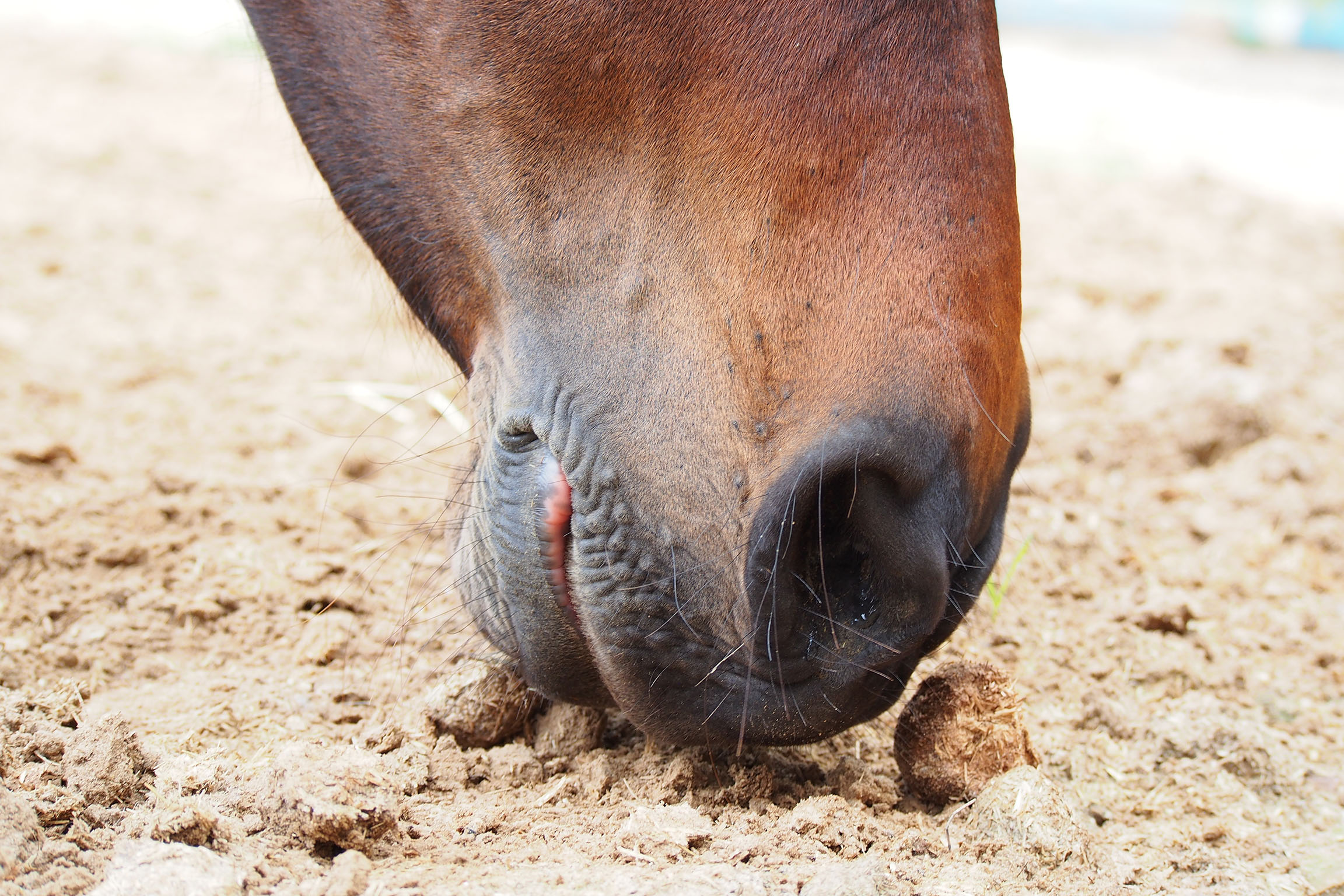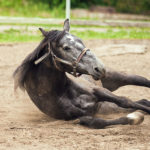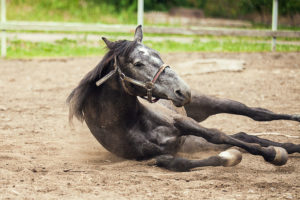
Sand Colic
Every horse owner is horribly familiar with the word, colic. It is something dreaded by owners and riders because, despite the best management practices, colic can strike even in the most well-managed yards.
Why are horses prone to colic?
A small stomach and an enormously long hind gut with plenty of twists and turns along the way is a fertile landscape for a blockage of food material. But the horse is also prey to other factors which can cause colic.
The intestine is populated with gut flora which digests the food and is specific to the dietary elements that need to be broken down. Change that environment suddenly and the digesting microbes have not had time to adapt and this can cause upset. Worm infestation, poor dental health or simple stress can also induce different types of colic. All any self-respecting horse owner can do is follow the best practice which will minimise the possibility of the horse suffering a colic episode. It won’t, however, eliminate it completely.
Different types of colic
Colic is a generic description of gut pain. The vet’s principal task is to establish what type of colic the horse is suffering from so an appropriate treatment plan can be determined.
There are different things which can cause the intestinal wall to spasm which is partly a cause of the intense pain the horse experiences. One of these is a physical blockage a popular reason for which is partly chewed or undigested food matter. Another contributor to a material obstruction is grains of sand producing sand colic.
What is a sand colic?
Sand colic is a specific type of colic caused by the ingestion of fine grains of sand from the soil. The horse accumulates these over time in locations where there is sandy soil and grazing is commonly sparse. If the horse is eating close to soil ground on poor pasture, it is easy to see how he will slowly uptake some of the contents of the soil.
Sand colic accounts for approximately 5% of total colic cases. As symptoms of colic can be quite generalised within a set range, the vet would need to determine that it is actually sand colic and does not have another causation. However, commonly these horses also present with diarrhoea which is not usually a symptom of other types of colic so this can be a significant indicator.
Sandy soil
Horses that graze in areas with sandy soil are clearly more vulnerable to sand colic. Grass quality is generally poorer in locations with this soil type and this contributes to the risk factor as good grass coverage clearly protects the horse from exposure to the soil beneath. Risk can be increased with horses on permanent sandy pasture by feeding grain on the floor and also hay when the grazing is depleted. Both hay and fodder need to be fed at chest height if possible to minimise exposure.
Signs and symptoms of sand colic
Many signs of colic are general and whilst clearly indicating that colic is present, may not signpost which type of colic the horse is suffering from. This has to be determined by a vet and time is of the essence. Some classic colic indicators include:-
· Pawing at the ground and snatching up with the hind legs or kicking out
· A bloated appearance to the abdomen of the horse which can indicate a large volume of gas
· Sweating
· Elevated heart rate and respiration
· Repeated rolling
· Box walking
· Disinterest in food and water
· A strange or unusual stance which the horse adopts to ease pain and discomfort
· Absence of gut noises or alternatively, a very noisy and overactive gut
· Swinging around and staring at the abdomen or trying to bite the area where the pain is located
· Diarrhoea which is one sign specifically linked to sand colic. This is caused by the abrasive nature of the sand grains against the intestinal wall and the loss of nutrient absorption resulting in watery droppings. However, not every horse with sand colic will exhibit diarrhoea
· There is a particular type of gut noise associated with sand colic, it sounds rather like the tide rolling in and rolling out, it is totally distinct to this specific type of colic
Sand colic can build up gradually. Initially, the number of sand grains the horse ingests will not make a difference or at least one that is discernible to the owner. If the horse is not removed from the pasture or other measures taken then the sand will increase and begin to trouble the horse. This type of colic has only one possible advantage in that there can be warning signs over the preceding weeks or months. Horses may have mild colicky type episodes which pass quickly without intervention. They may sometimes appear out of sorts or uncomfortable. Their droppings may begin to change in texture and appearance.
Relying on these signs is not an excuse to do nothing as horses exposed continuously to sandy pastures can easily go on to develop full-blown colic. Some horses don’t show any signs of trouble until serious colic is evident so you cannot rely on external warning signs potentially indicating the level of sand build up in the intestine.
Managing horses on sandy soil
Keeping horses on sandy soil may be unavoidable if that is your location but there are steps you can take to minimise your horses’ ingestion of sand grains. Sand colic does not have to be an inevitability of keeping horses on this type of land:-
· Promote good grass coverage by rotating grazing and never allowing paddocks to be overgrazed or bare
· If horses have to remain on spare pasture because there is no other available or they are on restriction for another reason such as laminitis, supplement inadequate grazing with a fibre source such as hay or haylage. Feeding adequate good quality forage will compensate for poor grazing and help promote healthy digestive function in its own right
· Feed hard feed and hay at chest height not on the ground
· Do not turn your horse out onto spartan grazing after the first rains of the season
· Monitor your horse’s droppings for any unexpected or unexplained changes
· Test the faeces by taking a few balls of dung and dropping them into clear water, about a quarter of a bucket full. Stir the manure until it is completely broken down and then let the contents of the bucket rest for about fifteen minutes. Pour the contents of the bucket through a fine-meshed sieve or rectal sleeve which will remove the water and any large elements leaving you with fine grains of sand if they are present. This is a good way to regularly check the droppings of horses grazed on this type of soil. Tiny amounts of sand may be present but anything more than the equivalent of a teaspoon would be a cause for concern.
The droppings test is neither fully reliable nor conclusive and the absence of any sand in that particular sample does not mean your horse is free from sand in his intestine. It is a good test as a routine and regular check for horse grazed on sandy pastures but is no substitute for calling the vet out if you suspect your horse has colic. Some horses will always show an element of sand in their droppings to no ill effect. Different horses can tolerate varying levels of sand in their gut with some showing less tolerance than others. Good husbandry is a very effective tool at keeping sand in the horse’s gut negligible or virtually non-existent.
Veterinary intervention
Diagnosis of sand colic is made on the presenting symptoms, owner’s history and circumstantial evidence. Digital radiography is now so advanced that vets can radiograph your horse’s abdomen to confirm the presence of sand, quantify the amount and assess the response to treatment. There are two types of treatment option which the vet may recommend. The main route which owners are familiar with is psyllium husks which are fed to help move the sand along the digestive tract. Your veterinarian may also “drench” your horse with psyllium to help shift the sand. This involves passing a nasogastric tube to administer the psyllium directly into the stomach.
Horses that have a large obstruction which may not clear with psyllium may require surgery to remove the build-up of sand.
What are Psyllium Husks?
Psyllium husks are derived from the seed of the Plantago Ovata plant. This plant has other names such as blond plantain, desert Indian wheat and blond psyllium. It is a medicinal plant found in western and southern Asia but it does also grow wild in parts of the United States. It is used in human laxative products such as Metamucil.
Psyllium husks are highly soluble fibre and can absorb a lot of water in the horse’s intestine. Sandflush is a natural psyllium husk pellet.
Benefits of feeding Sandflush include :
- Sandflush is made from 95% human-grade psyllium ensuring only the highest quality psyllium husk is fed to your horse.
- Sandflush is made in a Feedsafe accredited facility which undergoes stringest refugulatory measures.
- Sandflush is extremely palatable to even the fussiest of horses.
- Sandflush can has been Feedtested at only 13.6% sugar, meaning it is low-sugar and may be fed to horses and ponies prone to obesity or those suffering from Equine Metabolic Syndrome
Sandflush works as the pellets absorb water in the gastrointestinal tract to create a soft, sticky gel. As the husks pass through the intestines, they can collect the sand which adheres to the sticky substance and is then passed out via the manure. In the case of an actual bout of sand colic, once pain relief has been given, the vet may directly administer psyllium husks via a tube and this may be repeated several times a day for several days. It could be necessary to keep the horse hydrated via IV fluids. A large sand blockage that won’t shift may be potentially life-threatening and requires surgery.
Prevention is better than cure
If you have no option but to graze your horses on pasture with a sandy soil then you can feed your horse psyllium husks for one week in every month to ensure any sand ingestion is kept to an absolute minimum. Psyllium works best if it is fed intermittently rather than continuously. Long term use can diminish the effectiveness.
In a group of horses on the same pasture, some will always exhibit more sand in their faecal matter than others. Some horses are less fussy about what they eat – youngsters and foals who are more curious – and certain horses seem to favour licking the soil whereas others in the group will not. Treat each horse as an individual.
Never assume colic is caused by sand ingestion even if that appears highly likely and feed psyllium husks without taking veterinary advice. If the colic is in fact caused by something else, you could make the situation far worse.
Outcomes
On the scale of seriousness, sand colic is usually deemed to be towards the mild or moderate end of the scale and responds well to fairly conservative treatment. Left untreated however, and sand colic can prove fatal.



No comment yet, add your voice below!